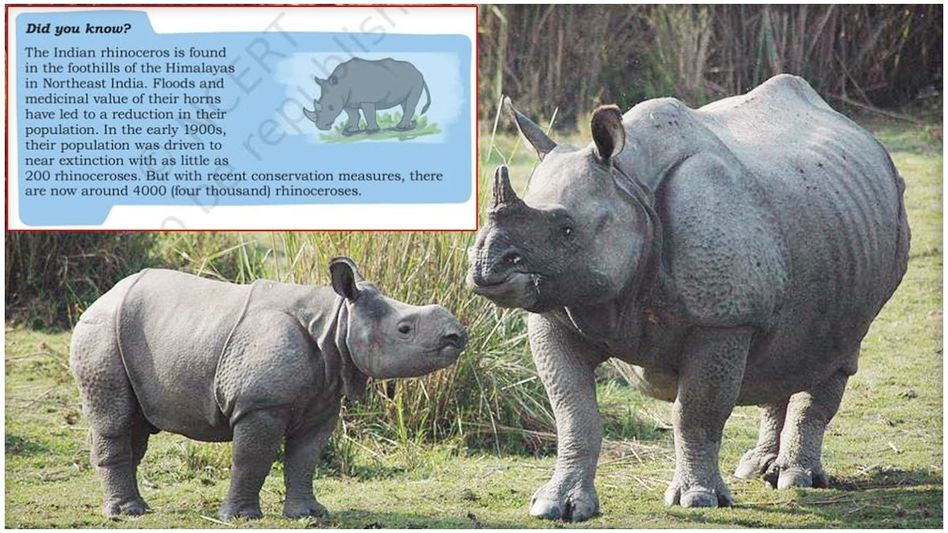Two-horned rhinos in India? NCERT class 4 textbook's rhino illustration sparks outrage
A textbook illustration and accompanying content has falsely depicted the Indian rhino as having two horns. The Greater One-Horned Rhinoceros, endemic to India, is so named because it possesses a single horn, distinguishing it from African species.

NCERT Class 4 mathematics textbook has ignited a storm of criticism from educators, wildlife conservationists, and activists for disseminating inaccurate and misleading information about Indian wildlife, particularly the endangered Indian rhinoceros (Rhinoceros unicornis).
A textbook illustration and accompanying content has falsely depicted the Indian rhino as having two horns. The Greater One-Horned Rhinoceros, endemic to India, is so named because it possesses a single horn, distinguishing it from African species.
Adding to the concern, the textbook further claims that rhino horns possess medicinal value, a dangerous myth that has long fueled the illegal poaching and international trafficking of rhinos. Rhino horns, made of keratin (the same protein as human nails and hair), hold no proven medicinal properties, a fact well-documented by conservation scientists and global health authorities.
The NCERT content states that these supposed "two-horned rhinos" are found in the foothills of the Himalayas in Northeast India. However, the actual range of the Greater One-Horned Rhino includes floodplains of the Brahmaputra valley in Assam, notably Kaziranga National Park, Pobitora Wildlife Sanctuary, and protected areas in West Bengal, Bihar, and Uttar Pradesh.
Leading conservation biologist Dr. Bibhab Kumar Talukdar, Secretary General of Aaranyak and a globally recognized expert on Asian rhinos, has publicly condemned the publication. Speaking to India Today NE, Dr Talukdar said, "Calling the Greater One-Horned Rhino a two-horned species is not only factually wrong but shows a failure of NCERT’s editorial oversight". Dr. Talukdar further warned that suggesting medicinal value in rhino horns could inadvertently encourage illegal trade and escalate poaching incidents.
He also pointed out a misleading remark in the book regarding floods in Assam being a cause of rhino population decline. "Floods are a natural part of Assam’s ecosystem and have never been a major factor in rhino population decrease," he emphasized. “In fact, Kaziranga’s rhino numbers have grown significantly despite annual flooding.”
"The mis-information on greater one horned rhino published by NCERT is very worrying. Greater one Horned it self reflect it is a one horned rhino and by putting two horn African rhino in the book has raised eyebrow on the quality check efforts at NCERT. Further Greater one horned rhinos are also found in flood plain ecosystem of Brahmaputra valley in Assam, besides foothills of Eastern Himalayas", said Dr Bibhab Talukdar while speaking to India Today NE.
He further added, "The book also mentions rhino horn has medicinal value that would provoke many people use rhino horn for medicinal purposes which may trigger more rhino poaching! I would like to remind the author and NCERT that flood in Assam is a natural phenomenon and very much essential for flood plain ecosystem. We have witnessed flood in Assam since 1950s and never in the history of Assam, flood has at any point contributed towards decline in rhino population. For example in 1966, Kaziranga had about 366 rhinos and since then many high flood hit Kaziranga, but rhino population has increased to about 2613 at present. Such wrong information provided, that's too in a book published by NCERT, reflects whom NCERT engages to write books which is very much worrying".
Renowned filmmaker and national award-winner film critic and former journalist Utpal Borpujari took to social media to flag the issue, questioning whether “two-horned rhinos are now found in India".
With growing public outrage, educators and conservationists are demanding immediate correction, withdrawal of the erroneous textbook, public accountability from NCERT, and stricter editorial scrutiny. Some have gone further, calling for legal action against those responsible for publishing such misinformation under India’s wildlife protection laws, as it could be construed as indirectly promoting the illegal trade of animal body parts.
Copyright©2025 Living Media India Limited. For reprint rights: Syndications Today









